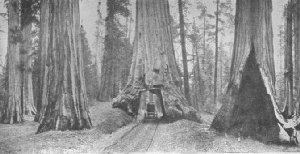|
In the state of California stand the oldest living things of the world—the "big trees."
This was all thousands of years ago, and to-day, in the specially, favorable localities where these old trees have stood for so many centuries, they impress us as almost the only survivors of a previous geological age. In the seaward ravines and slopes of the coast range which traverses California, stand the forests of Redwood. From just over the Oregon line down into Monterey County, California, the members of the gigantic tree tribe thrive only so far inland as the sea fog always sweeps—about 20 miles. On the slopes of the Sierras, scattered through the timber land of that region, in sheltered valleys, stand the ten separate forests of "Big Trees"—the only ones in the world. The area covered by these trees is not over 260 miles in length. In all, there are but a few hundred fairly large trees. Among these, the truly great ones do not number over 500. They are found set in mountain forests of great richness and grandeur. These forests are evergreen. The "Big Trees" are found in company with big Sugar and Yellow Pines, Firs and Cedars, which, themselves, rise from 175 to 200 feet in height. Above these tower, some hundred feet higher, the great crowns of the Calaveras Grove. A Sugar Pine ten feet through is a rarity, yet there are Sequoias of the Mariposa Grove 30 feet through, and many of them are 10 to 20 feet thick. Many of these trees when felled are big enough to accommodate a troop of cavalry on horseback. As to the age of these giants there is some uncertainty. Through counting their rings, some, 2,200 years old, have been found. One, that fell before the wind, was 4,000 years old. It is supposed that some of the trees now standing are 5,000 years of age. In fact, it has been said of them that, barring accidents, they are immortal. Part of this longevity is due to the fact that the Sequoias have a thick, fibrous bark that is all but fireproof, and thus affords protection from the numerous fires that kill smaller trees and vegetation. Also this bark prevents to a great degree the deadly effects of fungus growth, which lodges in scarred trees and rots back into the wood. One enemy has the Sequoia, and that is the lumberman, who is cutting down this noble tribe of trees for commercial use. By far the greater number are held in private ownersbip, although some of them are in forest reserves. The Mariposa Grove is owned by the state of California and is thus secure. But many other groves are rapidly falling. The trees do not multiply to any extent despite their superb strength. In the Calaveras Grove there are some trees 40 years old, but aside from these there is little sign of increase save in the limited area on the south fork of the Kaweah and the Tule rivers, where, although restricted, there is an abundant growth of trees of every age. Doubtless, action will be taken ere long to preserve to future generations the finest specimens of the old sentinels of the ages. WHERE THE VARIOUS AMERICAN INDUSTRIES ARE MAINLY CARRIED ON |
